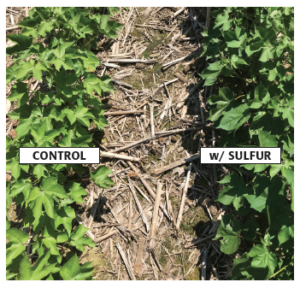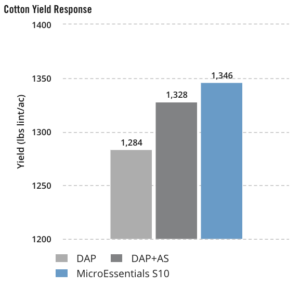OVERVIEW
- Diammonium phosphate (DAP) is a common phosphorus source used on cotton.
- University research highlights the need for sulfur (S) management on cotton and the importance of season-long availability (See Figure.1).
- MicroEssentials® S10® supplies multiple nutrients fused into one nutritionally balanced granule, promoting uniform nutrient distribution, increased nutrient uptake, a season-long S availability and higher yields.
Figure 1

TRIAL DETAILS
Crop: Cotton (Gossypium hirsutum L.)
Years: 2016-2018
Locations: 12 trials across 5 states – GA, MS, NC, SC, TN
Data Source: Field studies conducted by independent third-party researchers.
Experimental Design: Small-plot RCBD with 4 replications.
TREATMENTS:
Cropping Conditions: All trials conformed to local cropping practices
P Rate: 50 lbs P₂O₅/ac applied as DAP (18-46-0) or MicroEssentials® S10® (12-40-0-10S)
S Rate: 12.5 lbs S/ac from AS or MicroEssentials® S10®
Application Timing: Spring Preplant
Application Method: Broadcast incorporated
RESULTS

SUMMARY
- MicroEssentials® S10® increased cotton yield by 61 lbs lint/ac over DAP and 18 lbs lint/ac over DAP+AS.
- The results show that while lint yields increased with the addition of sulfate-sulfur, even better yields can be achieved when a season-long supply of S (sulfate + elemental) is provided.
- Higher cotton yields achieved by using MicroEssentials® S10® demonstrates the value of uniform nutrient distribution, increased nutrient uptake, and season-long S availability.
- Access additional yield data, ROI calculators, and resources at MicroEssentials – Performance.